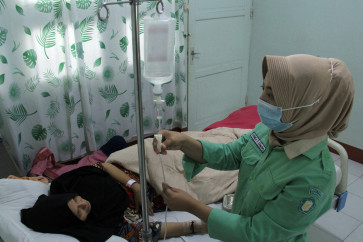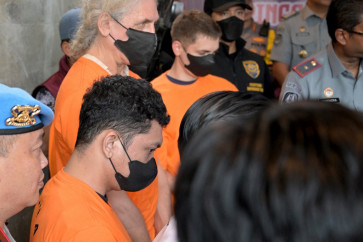Flood shelters still filled with displaced residents
Hundreds of people remained at shelters on Friday as villages in three districts in Cilacap, Central Java, were still submerged in floodwater
Change Size

H
undreds of people remained at shelters on Friday as villages in three districts in Cilacap, Central Java, were still submerged in floodwater.
Displaced people are staying at the Mulyasari village hall, which is serving as a shelter and is equipped with a kitchen and a health post.
Floodwater remains deep, almost 1 meter, so residents still cannot go home,” said village official Taryono. He said 143 people were currently staying at the village hall.
Flooding and landslides have occurred in several regions, such as Banyumas, Cilacap and Banjarnegara in Central Java, after days of heavy rain in the region. Roads in Cimanggu district are 2 meters under floodwater, cutting off access to West Java.
Banyumas Disaster Mitigation Agency (BPBD Banyumas) head Prasetyo Budi Widodo said no casualties had been recorded in the regency.
The National Disaster Mitigation Agency (BNPB) has recorded 1,853 natural disasters between January and October, suggesting that 2016 would be the most calamitous year the country has seen in the last five years.
The BNPB estimates that the number of catastrophes throughout the year is likely to exceed the current record from 2014, when 1,967 disasters occurred.
Of the 1,853 calamities from January to October, 89 percent were hydro-meteorological disasters such as flooding and landslides.
BNPB spokesperson Sutopo Purwo Nugroho said the strong La Niña weather phenomenon throughout the year, as well as the increasing sea surface temperature, partly contributed to the high number of disasters.
The La Niña phenomenon caused heavy rainfall from July to September, during which the country normally experiences a dry season.
In Merangin, Jambi, schools were temporarily closed after the Batang Tabir River overflowed.
“Nine villages are flooded, that’s why the schools decided to close,” said Merangin Deputy Regent Khafied Moein.
BPBD Jambi head Arief Munandar said that 1,106 houses in 117 villages had been submerged in floodwater between October and November.
Floods and landslides have also hit regions in Sumatra and Sulawesi.
Roads and bridges have been damaged by floodwater in Aceh Singkil, Aceh, making the regency inaccessible by four-wheeled vehicles.
Apart from transportation access, electricity to the affected areas has also been cut as 13 electric poles have been toppled by floodwater. Generators have been installed at shelters to serve displaced people.









